Dancing In The Dark
DIRECTED BY SYDNEY POLLACK/1969
STREET DATE: SEPTEMBER 5, 2017/KINO LORBER STUDIO CLASSICS
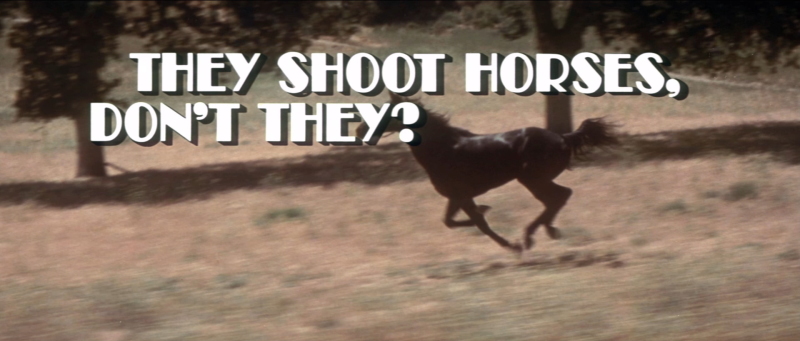
photo credit: DVDBeaver
Hardboiled author Horace McCoy (1897 – 1955) wrote some of the best titles in pulp fiction. His 1937 novel of tabloid journalism, amateur theatrics, and city-wide corruption reached oily wire racks as No Pockets in a Shroud. His 1938 novel about young Hollywood hopefuls summed up the experience of casting calls, starry-eyed ambition, and dashed hopes and dreams as I Should Have Stayed Home. And the title of his 1948 magnum opus, detailing the brutal rise and violent fall of a ruthless gangster, exploded from its lurid cover with the full force of a revolver blast to the face: Kiss Tomorrow Goodbye.
As a literary chronicler of the Depression, though, none of his subsequent novels had quite the forceful impact of his first, and after a decade of writing for publications like Black Mask found overnight success with his 1935 scorcher, They Shoot Horses, Don’t They? Compressing the misery and hopelessness of the era into an endless dance marathon, at an ocean-side ballroom reaching out beyond the sun-drenched shores of southern California, McCoy found a specificity to his trenchant powers of description equal to his unsparing talent for descriptive titles. Gloria and Robert, couple #22 in competition for a $1500 prize sponsored by Jonathan’s Non-Fattening Beer, reach a mutual understanding after 879 hours of swaying exhaustedly in each other’s arms. The waves pounding relentlessly beneath the floorboards, that moment of decision is as evocative of the time period as it is relevant to hard times in general.

reversible cover art images

reversible cover art images
Brought to the screen 34 years later, “22” becomes “67” and, setting back the action to the final year of both the Hoover Administration and Prohibition, “Jonathan” was apparently selling “Iron Tonic” in 1932 before selling “Non-Fattening Beer” in ’35. Two years after the Summer of Love, the 1969 movie, directed by Sydney Pollack and starring Jane Fonda and Michael Sarrazin as Gloria and Robert, changes more than the couple’s competition number and beverage sponsor, but in simultaneously adding new characters – such as elderly dance marathon veteran Sailor (Red Buttons) and stage-struck though delusional waif Alice (Susannah York) – and compressing the action to its shambling beachfront locale – excising the Paramount Studios casting-call meet-up of the novel – focuses and intensifies its source material while honoring the dramatic follow-through of McCoy’s bluntly telegraphed title.
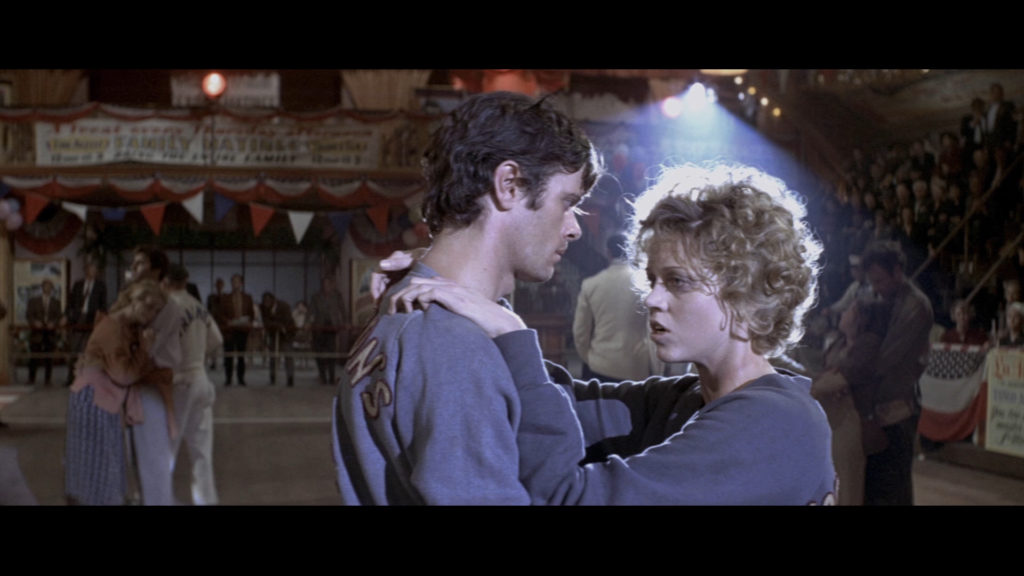
photo credit: DVDBeaver
Indeed, catchphrase that the film made the title, the hard-bitten, de-romanticized, decidedly un-rosy view of this particularly savage form of public entertainment remains as bracing as ammonia salts waved under nose and as harrowing as full-body ice-water baths retained for “dead” contestants on the sleep-deprived verge of the shivering willies. (Or heeby jeebies, if you will. In the film, these hallucinatory interludes are rather pointedly called “squirreling”.) Dancing at intervals of one hour and fifty minutes, with 10-minute rest periods in between, participants ate, shaved, and socialized in constant musical rhythm, the dreary monotony broken only by the bark of the MC’s running, biting, mocking commentary and, most terrifyingly, the dreaded 10-minute spectacle of the race-derby. A demonic pageant of human suffering, the structural strategy of the film’s expository dialogue exchanges – adding depth and nuance to the characters’ variously deprived backgrounds and individually desperate motivations – finds its thematic pay-off as the contestants race “round and round and round!” – “yowza! yowza! yowza!” – through two high-stakes set-pieces that bodily and mentally fracture these increasingly fragile participants with each rolling collision and grinding collapse.
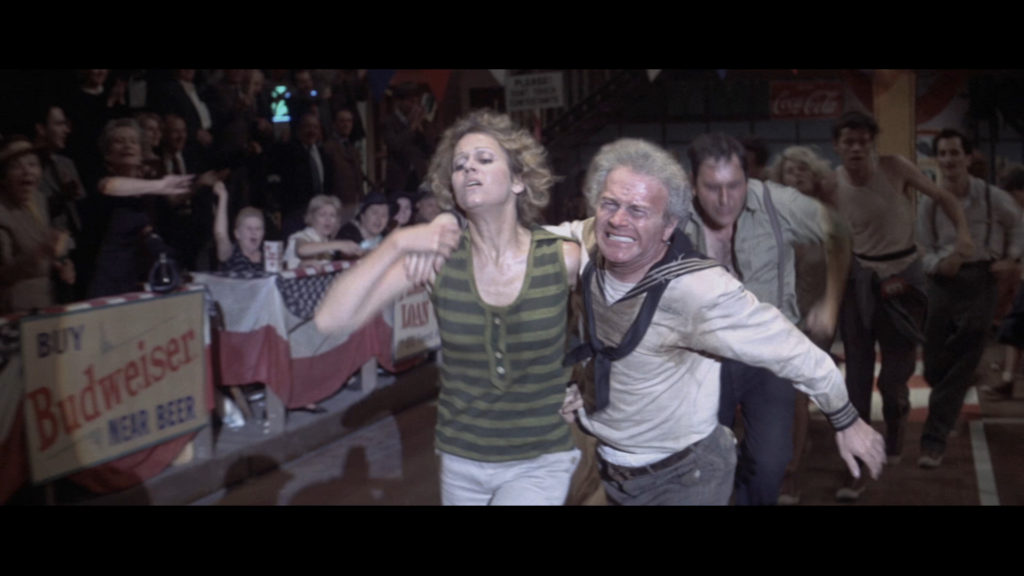
photo credit: DVDBeaver
Special mention in this regard should be made to the performances of Jane Fonda and MC Gig Young, the brittle toughness and sharp-tongued vulnerability of the former story-complementing the silver-tongued vulgarity and showbiz unctuousness of the latter. As actors who had previously been known for roles far removed from the darker depths of their characterizations plumbed here, the former the “it” girl of Cat Ballou (1965) and later an object of intergalactic sexualization in Barbarella (1968), and the latter a suave, martini-swilling second lead in Teacher’s Pet (1958) or That Touch of Mink (1962), it undoubtedly was – and in some ways still is – quite shocking to hear Fonda’s Gloria rather matter-of-factly telling a young and pregnant fellow contestant to have an abortion – “How ya gonna feed it?” – or Young’s MC spinning romantic lies on-stage – “A hero of the late war!” – while frankly propositioning vulnerable female participants off-stage. The greasy sweat under his pomaded brow and the unraveling wave-lines of her steam-ironed ‘do delineate that inner darkness as counter-effectively as the wide-eyed, fawn-like gaze of Sarrazin’s Robert, daily peering over the dance hall rafters for five minutes of rising sun, shows his character’s inner light.

photo credit: DVDBeaver
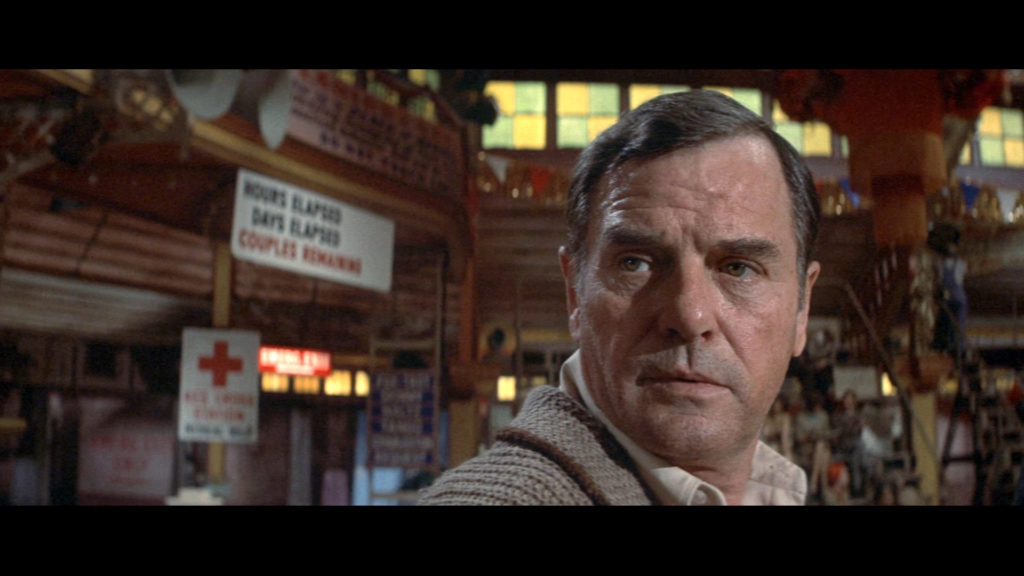
photo credit: DVDBeaver
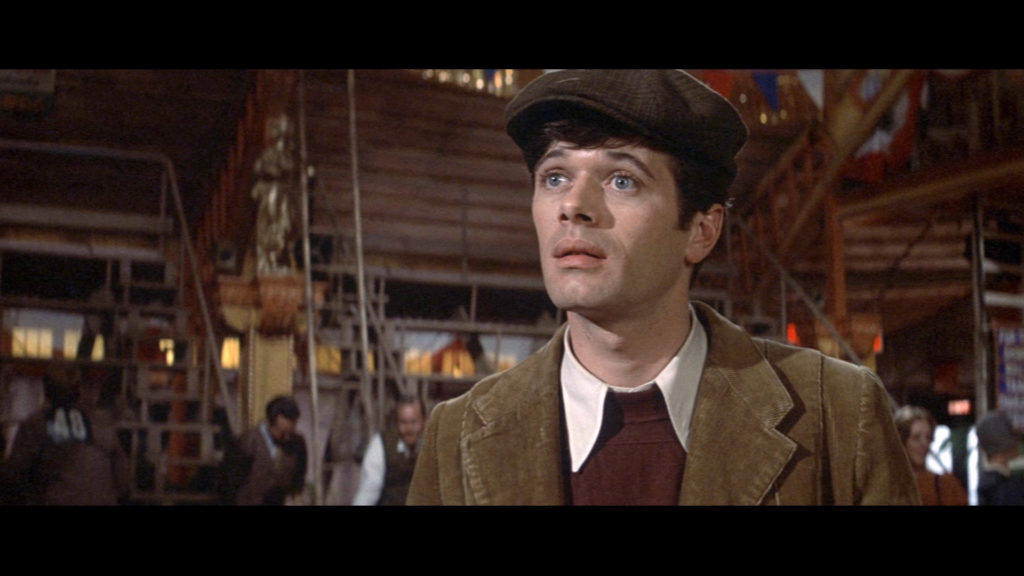
photo credit: DVDBeaver
That go-for-the-jugular tone, both titularly and thematically, is brilliantly served by director Sydney Pollack’s realistic style and screenwriter Robert E. Thompson’s extrapolation of its source material; which are in turn equally well-served by Kino Lorber’s first Blu-ray presentation of the mid-90s restoration of what was, for a time, a lost film. Two audio commentaries, from the restoration’s 1996 deluxe laser disc, accompany the Blu-ray: the first features Pollack on the complicated genesis of the project, expounding at entertaining length on its equally complicated production, and the second features interview tracks from many of the film’s cast and crew – including actors Jane Fonda, Bonnie Bedelia, Red Buttons, and Michael Sarrazin; producers Irwin Winkler and Martin Baum; along with some surprisingly invaluable comments from hair stylist Sydney Guillaroff. Together with a vintage making-of featurette and the film’s lengthy trailer – both highlighting the widescreen visual swirl of the derby sequences – the Blu-ray makes a strong case for the preservation of film history as intrinsic to our dramatic understanding of the past.
With its crystalline-reproduced anamorphic imagery, suggesting focal points beyond the clinch of dancers in the screen’s foreground, or its source music filling the film’s stereo-improved soundtrack with golden standards of the era, the visual and aural specificity of the tragic tale together offers any number of symbolic or allegorical interpretations, but the true test of time reveals this late ’60s film adaptation of a mid-’30s novel has as much relevance to the relentless cynicism of its respective periods as for the viewer today parsing the morality, or lack, of its title. In any event, from when he first dreamed it to the time his book was realized as a film, 14 years after the author’s death, They Shoot Horses, Don’t They? – title, book, and film – persists as author Horace McCoy’s final word on the value, or its lack, placed on human life.

photo credit: DVDBeaver

